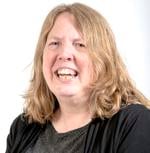
Mark Denman Elementary School social worker Chelsea Hulten talks in the school’s new laundry facility, mainly meant for use by homeless students and their families.
DANVILLE — Mark Denman Elementary School has a new facility it’s offering to local families affected by hardship, including the victims of a house fire over the recent spring break, a large family staying in a too-small hotel room, or students dealing with homelessness.
A laundry room.
“Those are our families that can really utilize this facility,” said school home liaison Jeremy Stimac. “We try to remove any barriers to education, and this is a barrier.”
The Danville school district completed the laundry facility at the K-4 school at the end of January, and it’s been used by a handful of families already. The goal was to help the approximately 230 homeless students and those at risk of being homeless and their families. Students can be considered homeless when they are living with other relatives.
Attendance can be affected, with students not wanting to go to school with dirty and smelly clothes, Stimac said. Parents also don’t want to be embarrassed by sending their kids to school looking that way, he said.
“Cleanliness can affect attendance,” Stimac said.
Stimac said he expects the laundry facility will be used a lot more at the start of the next school year, because the first three to four months of the school year is when more families experience homelessness.

Mark Denman Elementary School home liaison Jeremy Stimac, left, and social worker Chelsea Hulten talk about the new laundry facility at the Danville school.
He added that the district has a lot of resources for families to use as needed and it can’t always predict when those needs will occur.
“This isn’t just a Mark Denman facility. This is a district facility,” Stimac added.
Transportation can be another barrier with the laundry facility. Stimac said the district can also pick up families in its van and bring them to the facility.
Referrals are given to school social workers and/or building home interventionists. Families set up appointments and are accompanied by a social worker or home interventionist when using the facility. A district log is used for monitoring it and setting appointments.
The laundry room is in a former classroom that was split in half and only has access to outside.
“It’s created that extra security feature for us, which I think is nice,” said social worker Chelsea Hulten.
There are three combination washer/dryer machines. Laundry soap, dryer sheets and laundry bags are available for use.
There’s a sink, laundry-folding area, bulletin board with family resource information and table for school staff and families to work on their laptops.
There’s no cost for families to use the facility.
“I think that it’s important we empower our families,” Hulten said. “I think there’s a certain level of dignity of using a district resource” versus asking for help in the community from people they don’t know.
“I think them being able to contact us in the district, which they have existing relationships with us already, (is) easy for a parent to pick up the phone and call me and say, ‘Hey, I’m really struggling with this laundry, can you help me?’” she said. “And that’s absolutely no problem. We want to help them with that.
“I think that’s just a barrier that this has achieved, because that is hard for them to reach out to the community,” she added. “They don’t know where to start. They don’t know whom to call. They don’t know where to turn to. So it’s important for us to know that they can turn to the district and that we will help meet those needs for them.”
The district gets phone calls asking for help with space heaters, beds, clothes, laundry, diapers and other items.
Hulten said they can’t meet all needs, but that’s where the laundry facility came from. Administrators saw families struggling and wanted to help.
Mark Denman Elementary Principal Stacie Sollars came up with the idea after listening to a speaker at a conference talk about adverse childhood experiences.
“So, it kind of got me thinking that a lot of our kiddos, they’re not able to come to school because they don’t have clean clothes,” Sollars said.
“This is just huge,” added Kelly Truex, the district’s director of educational support programs. “It’s just a beautiful space. We’re thrilled with the facility.”
The cost was around $35,000 for the machines and other items, along with plumbing, electrical and flooring updates, with funding coming from a grant from the federal McKinney-Vento Homeless Assistance Act.









